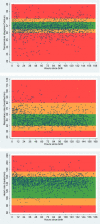Feasibility of using an Early Warning Score for preterm or low birthweight infants in a low-resource setting: results of a mixed-methods study at a national referral hospital in Kenya
- PMID: 33115899
- PMCID: PMC7594348
- DOI: 10.1136/bmjopen-2020-039061
Feasibility of using an Early Warning Score for preterm or low birthweight infants in a low-resource setting: results of a mixed-methods study at a national referral hospital in Kenya
Abstract
Introduction: Fifteen million babies are born prematurely, before 37 weeks gestational age, globally. More than 80% of these are in sub-Saharan Africa and Asia. 35% of all deaths in the first month of life are due to prematurity and the neonatal mortality rate is eight times higher in low-income and middle-income countries (LMICs) than in Europe. Early Warning Scores (EWS) are a way of recording vital signs using standardised charts to easily identify adverse clinical signs and escalate care appropriately. A range of EWS have been developed for neonates, though none in LMICs. This paper reports the findings of early work to examine if the use of EWS is feasible in LMICs.
Methods: We conducted an observational study to understand current practices for monitoring of preterm infants at a large national referral hospital in Nairobi, Kenya. Using hospital records, data were collected over an 8-week period in 2019 on all live born infants born at <37 weeks and/or <2500 g (n=294, 255 mothers) in the first week of life. Using a chart adopted from the EWS developed by the British Association of Perinatal Medicine, we plotted infants' vital signs. In addition, we held group discussions with stakeholders in Kenya to examine opinions on use of EWS.
Results: Recording of vital signs was variable; only 63% of infants had at least one temperature recorded and 53% had at least one heart rate and respiratory rate recorded. Stakeholders liked the traffic-light system and simplicity of the chart, though recognised challenges, such as staffing levels and ability to print in colour, to its adoption.
Conclusion: EWS may standardise documentation and identify infants who are at higher risk of an adverse outcome. However, human and non-human resource issues would need to be explored further before development of an EWS for LMICs.
Keywords: maternal medicine; neonatology; perinatology.
© Author(s) (or their employer(s)) 2020. Re-use permitted under CC BY-NC. No commercial re-use. See rights and permissions. Published by BMJ.
Conflict of interest statement
Competing interests: None declared.
Figures


References
-
- World Health Organisation Child causes of death 2000-2017. Available: https://www.who.int/healthinfo/global_burden_disease/estimates/en/index2... [Accessed 7 Feb 2020].
-
- United Nations UN sustainable development goals. Available: https://sustainabledevelopment.un.org/ [Accessed 14 Feb 2020].
-
- UNICEF UNICEF child mortality estimates: regional and global neonatal mortality rate. Available: http://data.unicef.org [Accessed 25 Jul 2019].
Publication types
MeSH terms
LinkOut - more resources
Full Text Sources
Medical
